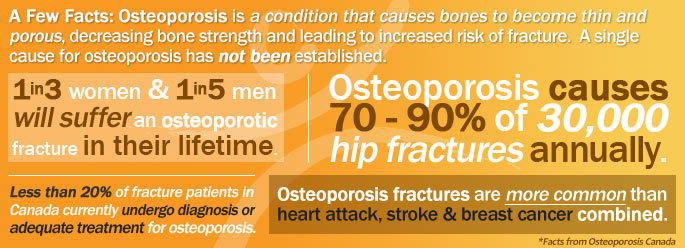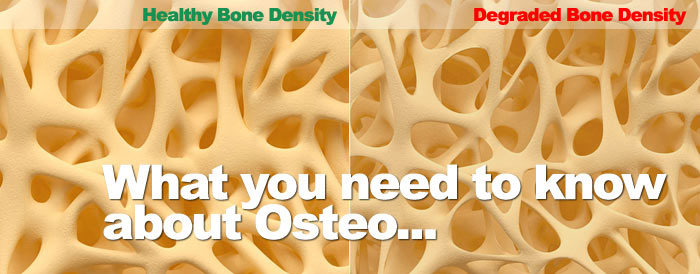Osteoporosis
Osteoporosis – What You Need to Know
Osteoporosis is a health condition that affects bones, leading to bone thinning and loss of density, ultimately affecting their structural integrity and leading to increased fracture risk. It can occur at any age, although is more common as age increases; 1 in 4 women and 1 in 8 men over the age of 50 are affected by it. It is often called the “silent thief” because it can be present without any active symptoms. Its presence can be confirmed definitively only by a Bone Mineral Density test, which is a special type of X-ray.

No single cause of osteoporosis has been identified. As we develop and grow through childhood and adolescence, we continue to build and “bank” bone until the age of 30. The more that we build bone during this critical period, the greater defence we have against the development of osteoporosis later in life. Bone “likes” to be exposed to regular, varying stresses to adapt and grow stronger; for example, playing soccer, which involves varying amounts of jogging, sprinting, jumping, and kicking, is an example of good stress. This means that everyone should be active from a young age and continue to remain active as they grow older to minimize the risk of osteoporosis, amongst many other health conditions – unfortunately this seems to be far from the norm.
The group at greatest risk of developing osteoporosis is post-menopausal women over the age of 50. While both men and women begin to naturally lose bone starting in their mid-30s, women lose bone at a much greater rate as they approach menopause – about 2-5% per year. This risk is even greater if they are physically inactive. This is because bone is a very active tissue with lots of turnover, the misconception is that we tend to think of it as a fixed structure. There are specialized bone cells that deconstruct it, mainly to access stored calcium for numerous bodily functions, and other specialized cells that reconstruct it as it adapts to the loads that we put on it. If we don’t put enough stress through it by moving and exercising, the reconstructing cells are insufficiently stimulated and there is a gradual loss of bone.
As mentioned above, the risk for fracture is much higher when osteoporosis is present. Areas that are most common to fracture are the spine and hip. Usually we would think that a significant trauma such as a hard fall or a car accident would be necessary to cause a fracture, but in osteoporosis much lesser forces are needed; even repetitive bending can be enough to cause a spinal fracture. Compounding this problem is that because people with osteoporosis are often less active, they do not have the same balance and strength as active people, and so are more prone to falls.
What can be done to counteract osteoporosis, or prevent it from happening in the first place? While medical interventions such as supplementary calcium and Vitamin D are important to ensure bones have the nutrients they need to remain strong, one important way to help manage your disease is through exercise. Just like muscle, bone adapts to the loads applied to it and become stronger. Our Newmarket Physiotherapy clinic has a specialized exercise program called Osteo-Circuit for those with osteoporosis or low bone density. You will be assessed by a physiotherapist to determine your suitability for the program and what your customized exercise plan should be. Inquire about the next 6 week program offered at our Newmarket Physiotherapy Clinic. Here’s to better and stronger bone health – you can do it!


